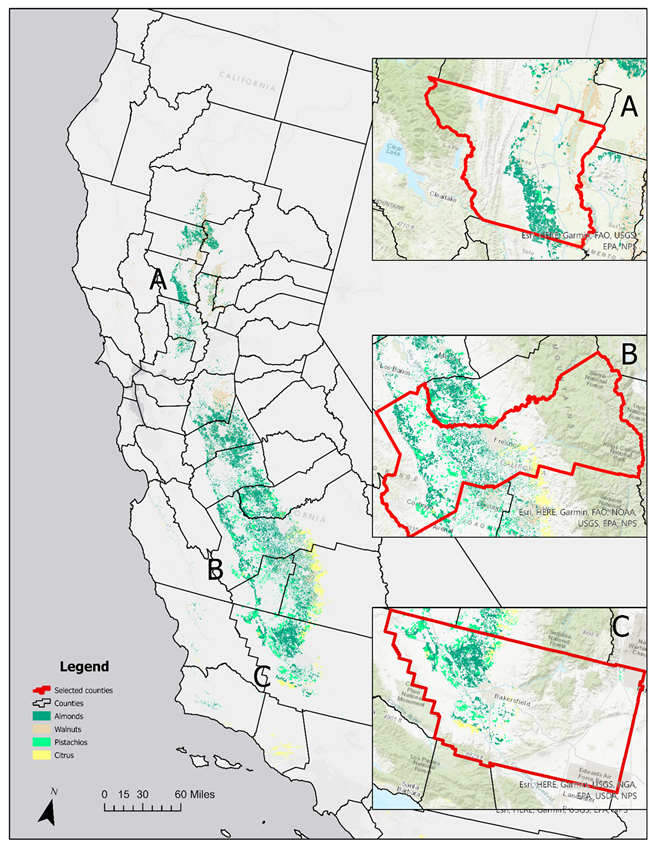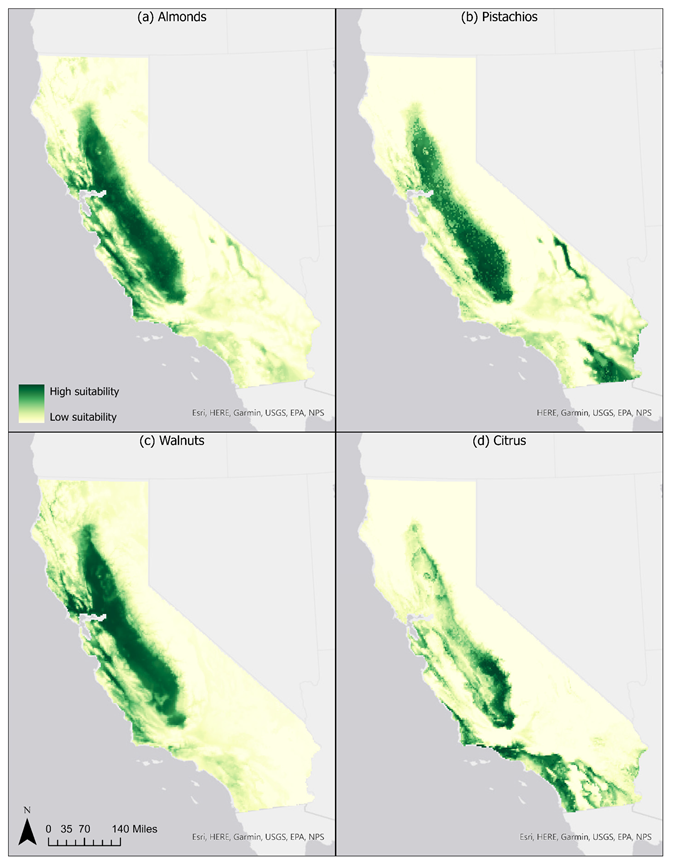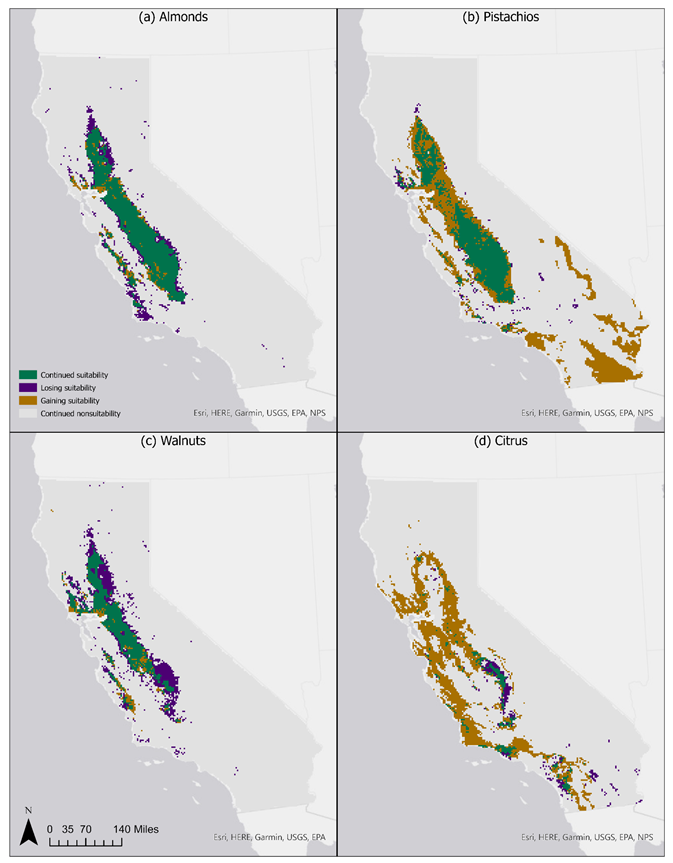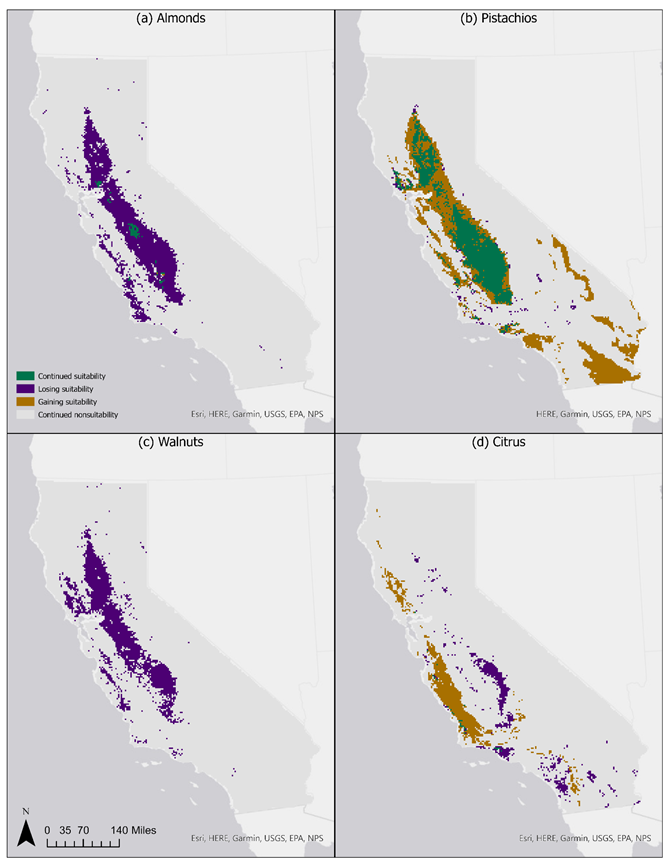Mid- and End-of-the-Century Estimation of Agricultural Suitability of California’s Specialty Crops
Abstract
1. Introduction
2. Material and Methods
2.1. Study Area
2.2. Cropland Data
2.3. Bioclimatic and Surface Data
2.4. Modeling Agricultural Suitability Distribution Range
3. Results
3.1. Baseline Specialty Crops Suitability Spatial Distribution
3.2. Projections for Specialty Crops Suitability under Climate Change
4. Discussion
4.1. Specialty Crops’ Suitability and Spatial Distribution Shift
4.2. Effects of Specialty Crops’ Suitability Shift
5. Conclusions
Supplementary Materials
Author Contributions
Funding
Data Availability Statement
Acknowledgments
Conflicts of Interest
References
- Bakhtavoryan, R.; Cheng, G.C.; Capps, O.; Dharmasena, S. A household-level demand system analysis of nuts in the United States. Agric. Resour. Econ. Rev. 2022, 51, 283–310. [Google Scholar] [CrossRef]
- Kerr, A.; Dialesandro, J.; Steenwerth, K.; Lopez-Brody, N.; Elias, E. Vulnerability of California specialty crops to projected mid-century temperature changes. Clim. Chang. 2018, 148, 419–436. [Google Scholar] [CrossRef]
- CDFA. California Agricultural Production Statistics 2019–2020; CDFA: Sacramento, CA, USA, 2021. [Google Scholar]
- Schauer, M.; Senay, G.B. Characterizing Crop Water Use Dynamics in the Central Valley of California Using Landsat-Derived Evapotranspiration. Remote Sens. 2019, 11, 1782. [Google Scholar] [CrossRef]
- Reisman, E. The great almond debate: A subtle double movement in California water. Geoforum 2019, 104, 137–146. [Google Scholar] [CrossRef]
- Fulton, J.; Norton, M.; Shilling, F. Water-indexed benefits and impacts of California almonds. Ecol. Indic. 2019, 96, 711–717. [Google Scholar] [CrossRef]
- Lobell, D.B.; Cahill, K.N.; Field, C.B. Historical effects of temperature and precipitation on California crop yields. Clim. Chang. 2007, 81, 187–203. [Google Scholar] [CrossRef]
- Pathak, T.B.; Maskey, M.L.; Dahlberg, J.A.; Kearns, F.; Bali, K.M.; Zaccaria, D. Climate change trends and impacts on California Agriculture: A detailed review. Agronomy 2018, 8, 25. [Google Scholar] [CrossRef]
- Parker, L.E.; Abatzoglou, J.T. Shifts in the thermal niche of almond under climate change. Clim. Chang. 2018, 147, 211–224. [Google Scholar] [CrossRef]
- Cook, B.I.; Ault, T.R.; Smerdon, J.E. Unprecedented 21st century drought risk in the American Southwest and Central Plains. Sci. Adv. 2015, 1, e1400082. [Google Scholar] [CrossRef]
- Parker, L.E.; Abatzoglou, J.T. Warming Winters Reduce Chill Accumulation for Peach Production in the Southeastern United States. Climate 2019, 7, 94. [Google Scholar] [CrossRef]
- Peter, B.G.; Messina, J.P.; Lin, Z.; Snapp, S.S. Crop climate suitability mapping on the cloud: A geovisualization application for sustainable agriculture. Sci. Rep. 2020, 10, 15487. [Google Scholar] [CrossRef]
- Caetano, J.M.; Tessarolo, G.; de Oliveira, G.; Souza, K.; Diniz-Filho, J.A.F.; Nabout, J.C. Geographical patterns in climate and agricultural technology drive soybean productivity in Brazil. PLoS ONE 2018, 13, e0191273. [Google Scholar] [CrossRef]
- Akpoti, K.; Kabo-Bah, A.T.; Dossou-Yovo, E.R.; Groen, T.A.; Zwart, S.J. Mapping suitability for rice production in inland valley landscapes in Benin and Togo using environmental niche modeling. Sci. Total Environ. 2020, 709, 136165. [Google Scholar] [CrossRef]
- Hirabayashi, K.; Murch, S.J.; Erland, L.A.E. Predicted impacts of climate change on wild and commercial berry habitats will have food security, conservation and agricultural implications. Sci. Total Environ. 2022, 845, 157341. [Google Scholar] [CrossRef] [PubMed]
- Akpoti, K.; Kabo-Bah, A.T.; Zwart, S.J. Agricultural land suitability analysis: State-of-the-art and outlooks for integration of climate change analysis. Agric. Syst. 2019, 173, 172–208. [Google Scholar] [CrossRef]
- Ahmadi, H.; Ghalhari, G.F.; Baaghideh, M. Impacts of climate change on apple tree cultivation areas in Iran. Clim. Chang. 2019, 153, 91–103. [Google Scholar] [CrossRef]
- He, K.S.; Bradley, B.A.; Cord, A.F.; Rocchini, D.; Tuanmu, M.N.; Schmidtlein, S.; Turner, W.; Wegmann, M.; Pettorelli, N. Will remote sensing shape the next generation of species distribution models? Remote Sens. Ecol. Conserv. 2015, 1, 4–18. [Google Scholar] [CrossRef]
- Zhang, C.; Valente, J.; Kooistra, L.; Guo, L.; Wang, W. Orchard management with small unmanned aerial vehicles: A survey of sensing and analysis approaches. Precis. Agric. 2021, 22, 2007–2052. [Google Scholar] [CrossRef]
- Varela, S.; Pederson, T.; Bernacchi, C.J.; Leakey, A.D.B. Understanding Growth Dynamics and Yield Prediction of Sorghum Using High Temporal Resolution UAV Imagery Time Series and Machine Learning. Remote Sens. 2021, 13, 1763. [Google Scholar] [CrossRef]
- Moon, M.; Richardson, A.D.; Friedl, M.A. Multiscale assessment of land surface phenology from harmonized Landsat 8 and Sentinel-2, PlanetScope, and PhenoCam imagery. Remote Sens. Environ. 2021, 266, 112716. [Google Scholar] [CrossRef]
- Sharma, R.; Kamble, S.S.; Gunasekaran, A. Big GIS analytics framework for agriculture supply chains: A literature review identifying the current trends and future perspectives. Comput. Electron. Agric. 2018, 155, 103–120. [Google Scholar] [CrossRef]
- Elith, J.; Leathwick, J.R. Species Distribution Models: Ecological Explanation and Prediction Across Space and Time. Annu. Rev. Ecol. Evol. Syst. 2009, 40, 677–697. [Google Scholar] [CrossRef]
- Silva, D.P.; Spigoloni, Z.A.; Camargos, L.M.; de Andrade, A.F.A.; De Marco, P.; Engel, M.S. Distributional modeling of Mantophasmatodea (Insecta: Notoptera): A preliminary application and the need for future sampling. Org. Divers. Evol. 2015, 16, 259–268. [Google Scholar] [CrossRef]
- Faleiro, F.V.; Silva, D.P.; de Carvalho, R.A.; Särkinen, T.; De Marco, P. Ring out the bells, we are being invaded! Niche conservatism in exotic populations of the Yellow Bells, Tecoma stans (Bignoniaceae). Nat. Conserv. 2015, 13, 24–29. [Google Scholar] [CrossRef][Green Version]
- Zeng, Y.; Low, B.W.; Yeo, D.C.J. Novel methods to select environmental variables in MaxEnt: A case study using invasive crayfish. Ecol. Model. 2016, 341, 5–13. [Google Scholar] [CrossRef]
- Barney, J.N.; DiTomaso, J.M. Bioclimatic predictions of habitat suitability for the biofuel switchgrass in North America under current and future climate scenarios. Biomass Bioenergy 2010, 34, 124–133. [Google Scholar] [CrossRef]
- Fitzgibbon, A.; Pisut, D.; Fleisher, D. Evaluation of Maximum Entropy (Maxent) Machine Learning Model to Assess Relationships between Climate and Corn Suitability. Land 2022, 11, 1382. [Google Scholar] [CrossRef]
- Hannah, L.; Roehrdanz, P.R.; Ikegami, M.; Shepard, A.V.; Shaw, M.R.; Tabor, G.; Zhi, L.; Marquet, P.A.; Hijmans, R.J. Climate change, wine, and conservation. Proc. Natl. Acad. Sci. USA 2013, 110, 6907–6912. [Google Scholar] [CrossRef]
- Granco, G.; Caldas, M.; De Marco, P. Potential effects of climate change on Brazil’s land use policy for renewable energy from sugarcane. Resour. Conserv. Recycl. 2019, 144, 158–168. [Google Scholar] [CrossRef]
- Parker, L.E.; Abatzoglou, J.T. Comparing mechanistic and empirical approaches to modeling the thermal niche of almond. Int. J. Biometeorol. 2017, 61, 1593–1606. [Google Scholar] [CrossRef]
- Parker, L.E.; McElrone, A.J.; Ostoja, S.M.; Forrestel, E.J. Extreme heat effects on perennial crops and strategies for sustaining future production. Plant Sci. 2020, 295, 110397. [Google Scholar] [CrossRef] [PubMed]
- Cabot, M.I.; Lado, J.; Clemente, G.; Sanjuán, N. Towards harmonised and regionalised life cycle assessment of fruits: A review on citrus fruit. Sustain. Prod. Consum. 2022, 33, 567–585. [Google Scholar] [CrossRef]
- Paz-Dyderska, S.; Jagodzinski, A.M.; Dyderski, M.K. Possible changes in spatial distribution of walnut (Juglans regia L.) in Europe under warming climate. Reg. Environ. Chang. 2021, 21, 18. [Google Scholar] [CrossRef]
- Lobell, D.B.; Field, C.B. California perennial crops in a changing climate. Clim. Chang. 2011, 109, 317–333. [Google Scholar] [CrossRef]
- CDFA. California Agricultural Statistics Review, 2017–2018; CDFA: Sacramento, CA, USA, 2018. [Google Scholar]
- United States Department of Agriculture-National Agricultural Statistics Service Cropland Data Layer (USDA-NASS CDL). USDA National Agricultural Statistics Service Cropland Data Layer. Publ. Crop-Specif. Data Layer 2022. Available online: https://www.usgs.gov/centers/fort-collins-science-center/science/usda-national-agricultural-statistics-service-cropland (accessed on 9 July 2023).
- Araújo, M.B.; Peterson, A.T. Uses and misuses of bioclimatic envelope modeling. Ecology 2012, 93, 1527–1539. [Google Scholar] [CrossRef]
- Fick, S.E.; Hijmans, R.J. WorldClim 2: New 1-km spatial resolution climate surfaces for global land areas. Int. J. Climatol. 2017, 37, 4302–4315. [Google Scholar] [CrossRef]
- Dewitz, J.; USGS. National Land Cover Database (NLCD) 2019 Products (Ver. 2.0, June 2021); U.S. Geological Survey: Reston, VA, USA, 2021. [Google Scholar] [CrossRef]
- Brown, J.L.; Bennett, J.R.; French, C.M. SDMtoolbox 2.0: The next generation Python-based GIS toolkit for landscape genetic, biogeographic and species distribution model analyses. PeerJ 2017, 5, e4095. [Google Scholar] [CrossRef] [PubMed]
- Rosenzweig, C.; Elliott, J.; Deryng, D.; Ruane, A.C.; Müller, C.; Arneth, A.; Boote, K.J.; Folberth, C.; Glotter, M.; Khabarov, N.; et al. Assessing agricultural risks of climate change in the 21st century in a global gridded crop model intercomparison. Proc. Natl. Acad. Sci. USA 2014, 111, 3268–3273. [Google Scholar] [CrossRef]
- Gomes, L.C.; Bianchi, F.J.J.A.; Cardoso, I.M.; Fernandes, R.B.A.; Filho, E.I.F.; Schulte, R.P.O. Agroforestry systems can mitigate the impacts of climate change on coffee production: A spatially explicit assessment in Brazil. Agric. Ecosyst. Environ. 2020, 294, 106858. [Google Scholar] [CrossRef]
- Santos, J.A.; Costa, R.; Fraga, H. Climate change impacts on thermal growing conditions of main fruit species in Portugal. Clim. Chang. 2017, 140, 273–286. [Google Scholar] [CrossRef]
- Parker, L.; Pathak, T.; Ostoja, S. Climate change reduces frost exposure for high-value California orchard crops. Sci. Total Environ. 2021, 762, 143971. [Google Scholar] [CrossRef] [PubMed]
- Elias, E.H.; Steele, C.M.; Havstad, K.; Steenwerth, K.; Chambers, J.C.; Deswood, H.; Kerr, A.; Rango, A.; Schwartz, M.W.; Stine, P.; et al. Southwest Regional Climate Hub and California Subsidiary Hub Assessment of Climate Change Vulnerability and Adaptation and Mitigation Strategies; United States Department of Agriculture: Washington, DC, USA, 2015; pp. 1–76. [Google Scholar]
- Luedeling, E.; Zhang, M.; Girvetz, E.H. Climatic changes lead to declining winter chill for fruit and nut trees in California during 1950-2099. PLoS ONE 2009, 4, e6166. [Google Scholar] [CrossRef] [PubMed]
- Zhang, N.; Pathak, T.B.; Parker, L.E.; Ostoja, S.M. Impacts of large-scale teleconnection indices on chill accumulation for specialty crops in California. Sci. Total Environ. 2021, 791, 148025. [Google Scholar] [CrossRef]
- Luedeling, E.; Gassner, A. Partial Least Squares Regression for analyzing walnut phenology in California. Agric. For. Meteorol. 2012, 158–159, 43–52. [Google Scholar] [CrossRef]
- Wilson, T.S.; Sleeter, B.M.; Richard Cameron, D. Future land-use related water demand in California. Environ. Res. Lett. 2016, 11, 054018. [Google Scholar] [CrossRef]
- Hong, C.; Mueller, N.D.; Burney, J.A.; Zhang, Y.; Aghakouchak, A.; Moore, F.C.; Qin, Y.; Tong, D.; Davis, S.J. Impacts of ozone and climate change on yields of perennial crops in California. Nat. Food 2020, 1, 166–172. [Google Scholar] [CrossRef]





| Specialty Crop | Scientific Name | Total Value (USD 1000) | Total Area (Square Kilometers) | Average Value per Area (USD) |
|---|---|---|---|---|
| Almonds | Prunus dulcis | 6,094,440 | 4775.3 | 1,276,242.3 |
| Pistachios | Pistacia vera | 1,938,800 | 1169.5 | 1,657,802.5 |
| Walnuts | Juglans regia | 1,286,410 | 1477.1 | 870,902.4 |
| Oranges, All | Citrus x sinesus | 670,529 | 594.8 | 1,127,318.4 |
| Lemons | Citrus x limon | 644,002 | 198.3 | 3,247,614.7 |
| Variable | Definition and Unit |
|---|---|
| bio1 | Annual mean temperature, Celsius degrees |
| bio2 | Mean diurnal range as the mean of monthly difference between maximum and minimum temperature, Celsius degrees |
| bio3 | Isothermality (bio2/bio7) (×100), unitless |
| bio4 | Temperature seasonality as the variation over three months (using standard deviation ×100) |
| bio5 | Maximum temperature of warmest month, Celsius degrees |
| bio6 | Minimum temperature of coldest month, Celsius degrees |
| bio7 | Temperature annual range as bio5–bio6, Celsius degrees |
| bio8 | Mean temperature of wettest quarter, Celsius degrees |
| bio9 | Mean temperature of driest quarter, Celsius degrees |
| bio10 | Mean temperature of warmest quarter, Celsius degrees |
| bio11 | Mean temperature of coldest quarter, Celsius degrees |
| bio12 | Annual precipitation, millimeters |
| bio13 | Precipitation of wettest month, millimeters |
| bio14 | Precipitation of driest month, millimeters |
| bio15 | Precipitation seasonality as the variation over three months (using coefficient of variation) |
| bio16 | Precipitation of wettest quarter, millimeters |
| bio17 | Precipitation of driest quarter, millimeters |
| bio18 | Precipitation of warmest quarter, millimeters |
| bio19 | Precipitation of coldest quarter, millimeters |
| elevation | Elevation, meters |
| slope | Gradient of land incline, degrees |
| aspect | Direction of downhill slope |
| land | Land cover/land-use for California |
Disclaimer/Publisher’s Note: The statements, opinions and data contained in all publications are solely those of the individual author(s) and contributor(s) and not of MDPI and/or the editor(s). MDPI and/or the editor(s) disclaim responsibility for any injury to people or property resulting from any ideas, methods, instructions or products referred to in the content. |
© 2023 by the authors. Licensee MDPI, Basel, Switzerland. This article is an open access article distributed under the terms and conditions of the Creative Commons Attribution (CC BY) license (https://creativecommons.org/licenses/by/4.0/).
Share and Cite
Granco, G.; He, H.; Lentz, B.; Voong, J.; Reeve, A.; Vega, E. Mid- and End-of-the-Century Estimation of Agricultural Suitability of California’s Specialty Crops. Land 2023, 12, 1907. https://doi.org/10.3390/land12101907
Granco G, He H, Lentz B, Voong J, Reeve A, Vega E. Mid- and End-of-the-Century Estimation of Agricultural Suitability of California’s Specialty Crops. Land. 2023; 12(10):1907. https://doi.org/10.3390/land12101907
Chicago/Turabian StyleGranco, Gabriel, Haoji He, Brandon Lentz, Jully Voong, Alan Reeve, and Exal Vega. 2023. "Mid- and End-of-the-Century Estimation of Agricultural Suitability of California’s Specialty Crops" Land 12, no. 10: 1907. https://doi.org/10.3390/land12101907
APA StyleGranco, G., He, H., Lentz, B., Voong, J., Reeve, A., & Vega, E. (2023). Mid- and End-of-the-Century Estimation of Agricultural Suitability of California’s Specialty Crops. Land, 12(10), 1907. https://doi.org/10.3390/land12101907







